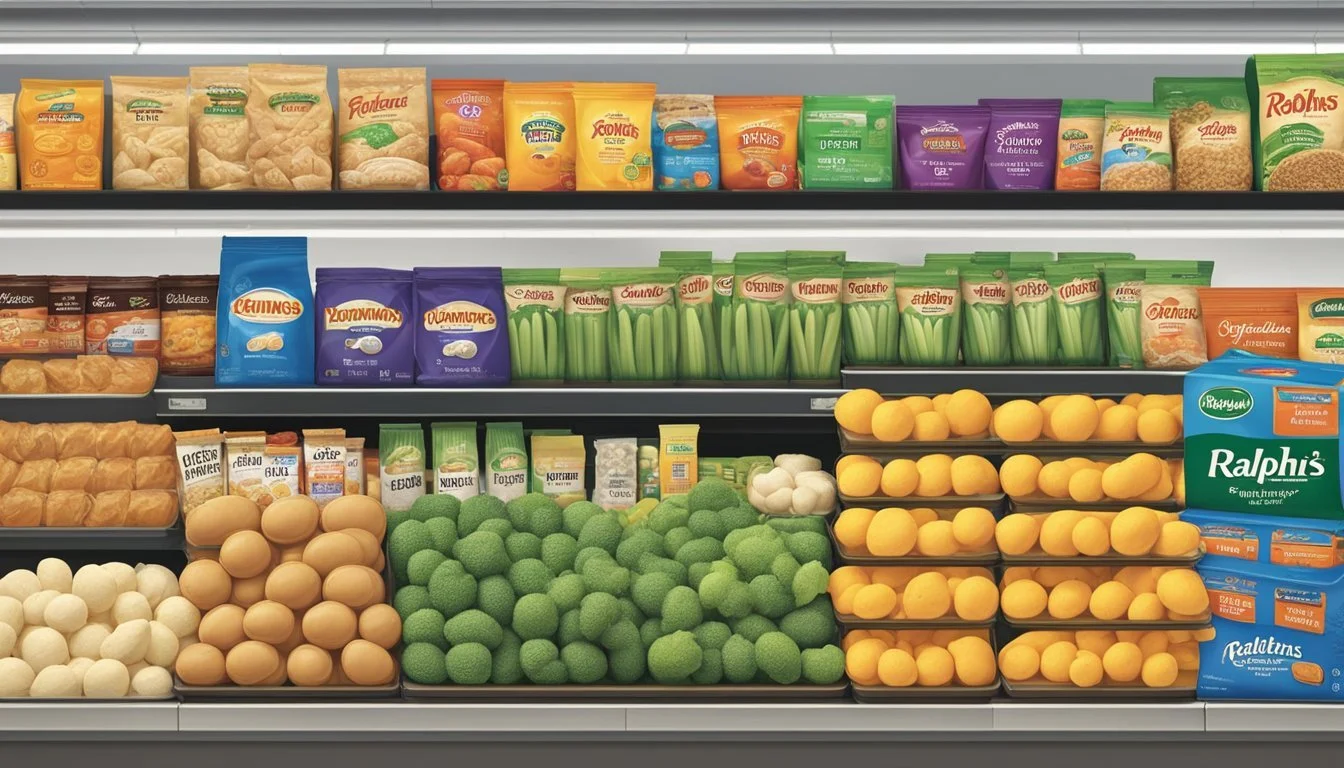Is Wegmans Cheaper Than Ralphs?
Comparing Grocery Prices
Part of Our Grocery Store Guide with Details on Wegmans Prices and Ralphs Prices
When comparing grocery store prices, consumers often look at two renowned chains, Wegmans and Ralphs, to determine which one provides the best value for their shopping needs. These two giants in the grocery industry have distinctive brand images, product selections, and pricing strategies. Wegmans, known for its strong brand loyalty, competes by offering a mix of store brands and premium products often associated with a higher quality shopping experience. Ralphs, on the other hand, positions itself as a traditional supermarket oriented towards offering value and convenience to its customers.
Price comparisons can vary based on numerous factors including geographic location, product mix, and current promotions. General observations suggest Wegmans has competitive pricing on its store-brand items, which are often seen as comparable to national brands in terms of quality. Their emphasis on store-brand products potentially allows them to offer better prices. Ralphs, being a key player in the Kroger family of supermarkets, also strives to provide value to customers, often through its association with Kroger branded products and cost-saving initiatives.
To understand if Wegmans is cheaper than Ralphs, it's important to look at a diverse range of products and consider various shopping scenarios. While individual product prices may be lower at one store, the overall shopping basket may cost less at another depending on the items selected and available offers. Also, factors like store loyalty programs, coupons, and clearance pages can impact the final prices paid by consumers, making the cost comparison a nuanced evaluation beyond mere shelf prices.
Overview of Supermarket Landscape
The supermarket landscape in the United States showcases a diverse array of stores catering to the needs of consumers. National chains like Walmart, Kroger, and Target lead the sector in terms of size and reach. Walmart is known for its extensive network of locations and competitive pricing. Kroger, meanwhile, stands out as a prominent grocery-specific chain with a strong national presence.
Specialty stores such as Whole Foods Market and Trader Joe's have carved out niches by focusing on natural and organic products and unique private-label items, respectively. Whole Foods, now owned by Amazon, has also spearheaded the integration of technology in grocery shopping. Amazon's entry into the brick-and-mortar space has introduced innovative concepts like cashier-less stores.
Discount grocery stores such as Aldi and Lidl have gained traction by offering low-price goods in a no-frills shopping environment, which counters the offerings of mid-range stores like Safeway and Albertsons. Similarly, membership-based warehouses such as Costco and Sam's Club provide bulk items at lower price points, appealing to consumers seeking value.
On the regional front, chains like Publix, Sprouts Farmers Market, and Harris Teeter have developed loyal customer bases. Publix is renowned in the southeastern U.S. for its customer service, while Sprouts emphasizes fresh, natural, and organic products. Midwest chain Hy-Vee offers a range of services including dine-in restaurants and online grocery ordering, reflecting a trend towards added convenience.
The competitive pricing of some supermarkets like Winn-Dixie and Safeway can differ significantly from higher-end markets. Amid this varied landscape, stores continually evolve, adapting to changing consumer preferences and economic factors.
Pricing Strategies in Grocery Retail
Grocery retailers employ various pricing strategies to attract and retain customers in a competitive market. Price is a primary factor influencing consumer choice, and retailers often adjust their strategies based on market trends and consumer behavior.
Discount stores such as Aldi emphasize low prices through minimal store design and private label brands. They reduce operating costs and transfer the savings to customers. Conversely, stores known for an expansive selection and superior customer service, like Wegmans, may reflect this in their prices which can be higher compared to discount chains.
Digital coupons and coupons play an integral role in creating temporary price reductions, thus providing savings for cost-sensitive shoppers. These can be particularly effective when used as part of a store's loyalty program, further incentivizing repeat business.
Price differentiation is also evident in competition between stores. H-E-B, recognized for its competitive pricing, may have lower prices than Wegmans, which places a higher emphasis on quality and customer service.
The spectrum of pricing strategies shows that while some consumers are attracted to expensive grocery options for their perceived value, others prioritize fundamental savings from lower-cost alternatives. This demonstrates the balance each retailer tries to achieve between price competitiveness and the value offered to their customers.
In summary, variations in pricing strategies are influenced by factors such as loyalty programs, competition, and customer preference between discounts and premium experiences.
Wegmans vs Ralphs: Comparative Analysis
When examining the differences between Wegmans and Ralphs, consumers typically focus on price comparison, selection, and quality.
Price Comparison: Consumer reports suggest that prices may vary between Wegmans and Ralphs for common items. Based on shopper feedback, items like a loaf of bread, gallon of milk, and a dozen eggs tend to be more affordable at H-E-B, indicating that Wegmans and Ralphs may have higher price points for these staples. To accurately assess each chain's pricing, customers may need to consider weekly ads and discounts that both Wegmans and Ralphs offer.
Table 1: Example Price Comparison (prices may vary)
Grocery Item Wegmans Price Ralphs Price Loaf of Bread Data Not Available $3.25 Gallon of Milk Data Not Available $3.00 Dozen Eggs Data Not Available $2.00
Selection: Both Wegmans and Ralphs are recognized for providing a diverse assortment of goods. While complete selection data is not specified, it is worth noting that Wegmans often receives praise for its broad range of offerings, which might include specialty and organic products not commonly found at other local grocers.
Quality: Quality is a hallmark of Wegmans, as it is regularly rated highly by Consumer Reports and other reviews. This could imply that they place a strong emphasis on premium products and customer experience. As for Ralphs, while there is no explicit mention of quality in the snippet, it is one of the major local grocery chains and is assumed to maintain a standard suitable for its customer base.
To summarize, both grocery chains have their respective strengths, and customers may select Wegmans or Ralphs based on personal preferences for cost, variety, and quality.
Product Range and Quality Comparisons
In comparing Wegmans and Ralphs, this section focuses on how each store provides a variety of products within key grocery categories and evaluates the quality of offerings available to consumers.
Fresh Produce
Wegmans boasts a robust selection of fruits and vegetables, including conventional and organic produce. Shoppers often find a diverse array of options, from staple vegetables like lettuce and tomatoes to exotic fruits. Ralphs offers a competitive range of fresh produce as well, with emphasis on seasonal and locally-sourced items. Both stores are recognized for their quality, with Wegmans particularly noted for its organic selection.
Meat and Dairy
The meat and dairy sections at Wegmans are known for their quality, with a wide array of choices such as ground turkey, cheddar cheese, and eggs. Ralphs also provides consumers with a respectable assortment of meats and dairy, including health-conscious options like lean cuts of meat and organic dairy products.
Bakery and Deli Options
Wegmans excels in the bakery and deli department, presenting shoppers with a vast selection of baked goods, including artisan bread and specialty cakes. Their deli counters offer a variety of meats and cheeses. Ralphs similarly offers a range of bakery and deli products, though Wegmans is often cited for superior in-store bakery freshness.
Pantry and Dry Goods
Both Wegmans and Ralphs provide extensive pantry staples, such as pasta and olive oil. The stores are on par with each other regarding the diversity of products. They both strive to cater to various dietary needs by including gluten-free and organic options in their inventory.
Frozen Food Selection
When it comes to frozen foods, both grocery chains offer a comprehensive selection. Consumers can expect to find everything from frozen broccoli to ready-to-cook meals. While Wegmans is associated with a more extensive assortment of healthy and specialty frozen items, Ralphs maintains a competitive range but may offer fewer premium options.
Store Services and Customer Experience
When evaluating store services, Wegmans stands out for its strong commitment to customer service. They ensure that shoppers not only come for the groceries but also enjoy the experience. This dedication to the consumer manifests in various services intended to enhance convenience. Wegmans offers a cohesive shopping list feature on their mobile app, allowing customers to plan their trip efficiently.
In contrast, Ralphs also provides robust customer services. They prioritize convenience with an online shopping list tool, which helps customers organize their shopping. One of Ralphs' advantages is the integration of their services with the Kroger network's well-established loyalty program, affording customers access to substantial savings and personalized deals.
Wegmans
Services: Comprehensive customer service, shopping list app, in-store cafes, and cooking classes
Loyalty Program: Wegmans shoppers can benefit from the Shoppers Club, which offers digital coupons and discounts
Ralphs
Services: Online shopping list, curbside pickup, and delivery options
Loyalty Program: As part of the Kroger family, customers gain from a wide-ranging loyalty program
Both stores invest in creating a positive customer experience, yet they take slightly different approaches. Wegmans focuses on the store environment and additional services that create an enjoyable shopping atmosphere. Ralphs leans towards leveraging a broader network's loyalty scheme, adding value through cost savings. Each retailer's strategy is tailored to their brand's strengths and customer base preferences.
Brand and Store Loyalty
When consumers make a decision between Wegmans and Ralphs, brand and store loyalty often come into play. Shoppers may develop loyalty to a particular store for myriad reasons, such as product offerings, quality, price, and the overall shopping experience.
Wegmans is renowned for its customer experience and has a strong store brand that provides a wide range of products, including organic and gourmet options. The Wegmans brand appeals to those seeking a combination of quality and value. Ralphs, on the other hand, is part of the Kroger family and offers its own store brand, which competes with other store brands in terms of price and quality.
Store Brands:
Wegmans: Often prides itself on its organic and gourmet options.
Ralphs: Features a variety of products to cater to diverse consumer needs.
Comparison With Other Brands:
Great Value: Walmart's store brand, known for its affordability.
365 by Whole Foods Market: Targets consumers looking for natural and organic products.
Shoppers may choose Wegmans for its unique brand products, or Ralphs if they value the familiarity and reliability of the Kroger network’s offerings. Both stores aim to create loyalty through their store brands, ensuring customers can find both value and quality without necessarily having to rely on national brands.
Ultimately, store loyalty may also be influenced by other factors such as location convenience, customer service, and store policies. While Wegmans and Ralphs both endeavor to build loyal customer bases through their store brands, consumer choice can be swayed by individual preferences and values, such as Wegmans’ focus on a unique shopping environment or Ralphs’ support for unions.
Regional Presence and Accessibility
When comparing Wegmans and Ralphs, one must consider their distinct regional footprints and how they facilitate access to their respective customer bases.
Geographic Distribution
Wegmans primarily operates in the Northeast and Mid-Atlantic regions, with a strong presence in New York. As a regional grocery chain, they have crossed the 100-store mark, servicing areas like Rochester, near the SUNY Buffalo campus, and extending their reach into states like Virginia through strategic distribution centers.
In contrast, Ralphs serves customers as a part of the Kroger family and has a more extensive reach within California. As a subsidiary of the nation's largest supermarket chain, it benefits from a broader national presence which potentially influences its accessibility and footprint.
Online Reach and Digital Impact
Both Wegmans and Ralphs understand the importance of an online presence, leveraging platforms like Facebook to engage with their market and foster community. They each offer online shopping experiences, integrating digital advancements to compliment their physical stores.
Wegmans has capitalized on crafting localized product offerings through its digital channels, ensuring that the in-store experience is mirrored online for customers who prefer e-commerce options.
Ralphs offers online services that align with its larger national presence, attempting to provide diverse offerings to meet the varied needs of its widespread customer base across various locations.
Consumer Spending Habits
When families assess their grocery list, factors like price, quality, and convenience steer their decisions towards where to shop for lunch, dinner, and snacks. Wegmans and Ralphs fall into the context of these decisions, with each store drawing in consumers through varying strategies.
Families typically prepare a shopping list aiming to optimize their spending while not compromising on their meal quality. Wegmans, known for a wide selection of quality offerings, may influence a household's grocery list by providing diverse options for meals and snacks. Yet, this can come at a cost that may reflect on the spending habits of consumers who prioritize quality over cost.
On the other hand, Ralphs is often associated with offering cost-saving opportunities that might appeal to households aligning their grocery shopping with a strict budget. The store's pricing on essentials could result in a noticeable difference in a family's expenditure compared to shopping at Wegmans.
A practical shopping list might include:
Lunch: Deli meats, bread, and condiments.
Dinner: Fresh produce, protein sources, and staple grains.
Snacks: Packaged goods, fruits, and dairy or plant-based alternatives.
Consumers also consider loyalty programs, personalized coupons, and weekly deals, all of which can sway their preferences when refining a shopping list to maximize savings without compromising the diversity of their meals.
In essence, spending habits are shaped by both immediate price points and perceived long-term value, thereby influencing whether families shop at Wegmans or Ralphs for their grocery needs.
Promotional Strategies and Effects
When comparing Wegmans and Ralphs, it's important to consider the impact of their promotional strategies on pricing and customer perception. Wegmans has a distinct approach that entails providing value through consistent low prices and bulk purchase options, such as their Family Packs. Studies have indicated that prices at Wegmans can be up to 13% cheaper than competitors like Giant or Safeway.
Wegmans: They implement a multi-faceted promotional strategy that includes:
Consistently Low Prices: Maintained on popular items, ensuring affordability.
Family Packs: Offering bulk purchases at reduced rates, attracting budget-conscious customers.
Seasonal Promotions: Regularly adjusting offers to align with seasonal demand.
Ralphs: Contrastingly, Ralphs might rely more heavily on:
Weekly Ads: Featuring discounted items to drive store traffic.
Loyalty Programs: Encouraging repeat purchases through rewards.
Comparing the effects of these strategies, customer loyalty is influenced by both the perception of value and the actual savings gleaned from promotions. However, the precise impact on individual customers can vary, as some might prioritize everyday low prices while others may be drawn to specific discounts available through loyalty programs.
The presence of other players like Shoprite and IGA in the market also affects promotional tactics. Wegmans and Ralphs must navigate through the promotions put forth by these competitors. The effectiveness of their strategies is partly assessed through customer surveys, which provide feedback on customer satisfaction and the perceived value of the promotions.
In summary, while both Wegmans and Ralphs employ promotional strategies to appeal to their customer base, Wegmans often positions itself as the more cost-effective option due to their emphasis on everyday low pricing and bulk discounts.
Supply Chain and Supplier Relationships
Wegmans Food Markets maintain a notable reputation for its supply chain efficiency, which is in part due to its robust supplier relationships. Wegmans collaborates with suppliers to enhance joint performance, focusing on the effectiveness of the entire supply chain rather than just their individual performance. This collaborative approach has been refined through initiatives such as their New Ways of Working Together trading partner collaboration pilot.
Key Aspects of Wegmans' Supply Chain:
Data Synchronization: Their Data Sync and Accuracy team uses Internet technology to drive value across the supply chain.
Supply Chain Integration: Wegmans aims to integrate processes to improve connectivity, communication, and collaboration with the global commerce community.
Supply Chain Resilience: Despite facing supply chain disruptions, especially during the pandemic, Wegmans has demonstrated a capability to keep shelves stocked. They showed resilience in adapting their supply chain operations to maintain consistent product availability.
Comparatively, Stop & Shop, operating within a similar market space, might utilize different strategies or may not have the same emphasis on supplier collaboration as Wegmans, which could impact their retail prices.
Suppliers play a critical role in retail pricing, and the strength of the relationship between retailers and their suppliers can influence costs. While it is not explicitly stated how these dynamics compare between Wegmans and Ralphs, efficient supply chain management can contribute to lower operational costs and potentially more competitive prices. Therefore, understanding this aspect of Wegmans is vital when evaluating its pricing relative to competitors such as Ralphs.
Conclusion
When evaluating supermarket chains such as Wegmans and Ralphs, consumers often prioritize cost-effectiveness. Data from comparative analyses reveal that there is no definitive answer to which store is cheaper as prices can vary based on product type, location, and available promotions.
Wegmans is noted for its competitive pricing on select produce, such as bananas and apples, making it a marginally cheaper option for these items compared to Kroger. There is no direct price comparison available in the data for Walmart Supercenter or ACME regarding these products. However, it is well-known that Walmart Supercenter generally offers low prices due to its vast buying power.
Ralphs and Wegmans both offer an array of discounts and weekly ads, which can influence the total cost. The key for shoppers is to stay informed on current promotions and to compare prices regularly.
Price disparities could be influenced by the following factors:
Geography
Brand selection
Store brand versus national brand
Seasonal deals
In essence, consumers benefit from closely scrutinizing weekly ads, considering store brand products, and leveraging loyalty programs offered by these chains. It is advisable to shop according to individual needs, preferences, and value for money rather than seeking an absolute answer to which supermarket is the least expensive. The debate over which supermarket chain offers the best value for money will continue to hinge on dynamic pricing strategies and consumer preferences.











